ARRL ARDF Committee Members
Members of the new American Radio Relay League (ARRL) ARDF Committee were officially approved at the January 2020 meeting of the ARRL Board of Directors. ARDF Co-Coordinators and Co-Chairs of the committee are Jerry Boyd WB8WFK and Charles Scharlau NZØI. Also serving on the main committee is Richard Arnett WB4SUV. The ARDF Committee Terms of Reference establishes a framework with the overall Co-Coordinators overseeing three subcommittees: Team Selection, Sanctioning and Rules.
The Team Selection Subcommittee establishes a fair and equitable ranking system to be used for selecting members of ARDF Team USA to the biennial ARDF World Championships. The subcommittee also implements this system to make the team selection for approval by the full committee. After approval, the subcommittee issues invitations to potential team members and handles administrative duties relative to submission of the team roster and fees to the World Championships organizers. Co-chairs of this subcommittee are Ruth Bromer WB4QZG and Nadia Scharlau KO4ADV. Other members are Joseph Burkhead KE8MKR and Thomas Chen.
The Sanctioning Subcommittee establishes and publishes processes and standards for selecting hosts for the USA ARDF Championships and other ranking events, the results of which are important for determining members of ARDF Team USA. Following these standards, the subcommittee selects hosts for upcoming annual USA ARDF championships for approval by the full committee. Subcommittee members are Robert Frey WA6EZV, Jennifer Harker W5JEN, Cameron Haynes and Lori Huberman.
The Rules Subcommittee solicits comments and suggestions for changes in ARDF rules, then makes proposals and recommendations to the full committee. Upon approval, these rules are to be used for ARRL-sanctioned ARDF competitions. The subcommittee also coordinates with leaders of IARU Region 2 regarding ARDF rules. Chair of this subcommittee is Joseph Huberman K5JGH. Other members are Donald Pitchford W9EBK and Nadia Scharlau KO4ADV. The first version of USA's official Rules for Amateur Radio Direction Finding, dated February 9, 2020, was created by the rules subcommittee and approved by the full ARDF Committee. Download these rules here.
Named as ARRL ARDF Representative to IARU Region 2 is Kenneth Harker WM5R, who also serves as IARU Region 2 ARDF Coordinator.
Hometowns and brief biographies of these committee members are in Attachment 1 of the ARDF Committee's January 2020 Report to the ARRL Board of Directors, which can be downloaded from the ARRL Web site. E-mail address for the ARRL ARDF Committee is ardf@arrl.org.
The ARRL ARDF Committee now has a page on the ARRL Web site. Joseph Burkhead KE8MKR of the committee has set up a database of upcoming ARDF events all over the USA. View this list of events here.
IARU Region 2 ARDF Leadership
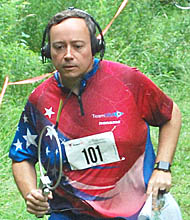
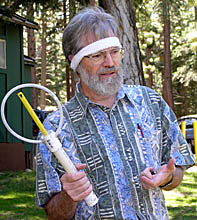 Not long after I was appointed as USA ARDF Coordinator, I was also asked to serve as ARDF Coordinator for Region 2 of the International Amateur Radio Union (IARU). I soon realized that there was too much workload for one person to handle both positions. So in 2001, Dale Hunt WB6BYU (at left) stepped forward to become the IARU ARDF Coordinator for Region 2 (North and South America).
Not long after I was appointed as USA ARDF Coordinator, I was also asked to serve as ARDF Coordinator for Region 2 of the International Amateur Radio Union (IARU). I soon realized that there was too much workload for one person to handle both positions. So in 2001, Dale Hunt WB6BYU (at left) stepped forward to become the IARU ARDF Coordinator for Region 2 (North and South America).
Dale was a long-time hidden transmitter hunting enthusiast when he and his wife Kuon KB7WRG helped to organize the 1991 Friendship Radiosport Games in Portland, Oregon, which included the first international ARDF event on USA soil. Eight years later, Dale and Kuon chaired the organizers of the first IARU Region 2 ARDF Championships near Portland. Dale has been a frequent medal winner at ARDF championships within Region 2 and was on ARDF Team USA to the World Championships on six occasions.
Dale served for almost seventeen years and retired in August 2018. Replacing him is Kenneth Harker WM5R (at right) of Austin, Texas. Ken Harker has been involved in ARDF since 2002. He has won medals at the USA ARDF Championships numerous times and was on ARDF Team USA to the ARDF World Championships in 2010, 2014, 2016 and 2018. He and his wife Jennifer W5JEN organized the USA ARDF Championships in 2008 and 2016. Ken writes, "I hope to live up to Dale's legacy and I look forward to working with everyone on ways we can grow and promote ARDF in Region 2."
In addition to promoting the growth of ARDF within the region, Ken represents the region and works with the ARDF Working Groups in IARU Regions 1 and 3 to refine ARDF rules and to plan international events. He has a personal ARDF Web page that includes his contact information.
A Growing Sport in Canada
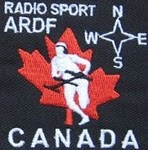
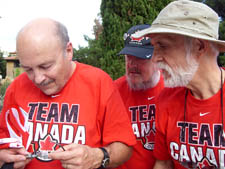 The first formal international-rules ARDF event in North America took place during the Second Friendship Radiosports Games in Portland in 1991. Two years later, hams in Victoria, BC Canada hosted the Third Friendship Games, including that country's first radio-orienteering event. Those hams formed the nucleus of a group that continues to grow and promote ARDF throughout all of Canada.
In 1997, Perry Creighton VA7PC of Victoria, one of the Friendship Games organizers, was selected by Radio Amateurs of Canada to became the first national ARDF Coordinator in North America. Joe Young VE7BFK, a participant in those 1993 games, succeeded him as RAC's ARDF Coordinator in 2002. Upon VE7BFK's retirement in 2025, Rob Haddow, VE3JT/VE3RXH of Kemptville, Ontario was named to replace him.
The first formal international-rules ARDF event in North America took place during the Second Friendship Radiosports Games in Portland in 1991. Two years later, hams in Victoria, BC Canada hosted the Third Friendship Games, including that country's first radio-orienteering event. Those hams formed the nucleus of a group that continues to grow and promote ARDF throughout all of Canada.
In 1997, Perry Creighton VA7PC of Victoria, one of the Friendship Games organizers, was selected by Radio Amateurs of Canada to became the first national ARDF Coordinator in North America. Joe Young VE7BFK, a participant in those 1993 games, succeeded him as RAC's ARDF Coordinator in 2002. Upon VE7BFK's retirement in 2025, Rob Haddow, VE3JT/VE3RXH of Kemptville, Ontario was named to replace him.
In 2010, Canada sent a team to the ARDF World Championships for the first time. Team Canada participated in the Sixth IARU Region 2 ARDF Championships in Albuquerque, New Mexico during 2011.
The "Why Just Run" Web site announces ARDF events all over the country and provides Canadian hams with information about the sport and about ARDF Team Canada.
In the photo at right above: Three ARDF Team Canada members examine a miniature transmitter at the ARDF World Championships in Croatia during 2010. They are Les Tocko VA7OM, Joe Young VE7BFK and John MacConnachie VE7GED. (Photo by Ken Harker WM5R)

Radio-Orienteering Bibliography
Homing In columns on international ARDF by Joe Moell KØOV in 73 Magazine (1988-2003), CQ-VHF Magazine (2004-2013), CQ-Plus digital magazine (2014) and CQ magazine (beginning 2015)
- June 1991 -- Hunting for the Gold
- September 1991 -- Foxhunters Invade Oregon
- December 1991 -- RDF Spans the Globe
- April 1992 -- Foxhunt Fame Awaits You
- July 1992 -- RDF Opportunities Abroad and at Home
- October 1993 -- Foxhunt Fun at the Friendship Games
- December 1995 -- Foxhunting's Wide World
- January 1996 -- More About Hamcon/Foxhunt-95
- April 1996 -- Foxhunting the European Way
- August 1996 -- Bringing ARDF To Your Town
- September 1996 -- Foxhunt Day, Step By Step
- December 1996 -- Globetrotting Foxhunters
- January 1997 -- A Foxhunting Jamboree
- April 1997 -- New Ideas Never Cease
- December 1997 -- New Sporting Goods for Foxhunting
- January 1998 -- FARS, Friendship and Foxhunting
- March 1998 -- Radio Foxes Don't Howl
- June 1998 -- ARDF is Off and Running
- November 1998 -- Practice, Education and Fun
- January 1999 -- A Banner Year, More to Come
- May 1999 -- Dayton, Portland and South Texas
- October 1999 -- City of Roses...and Foxes
- April 2000 -- ARDF Takes Off in 2000
- October 2000 -- USA Foxhunting Championships 2001 -- Start Planning!
- November 2000 -- 80-Meter ARDF Comes to America
- January 2001 -- A New Millennium of Foxhunting
- February 2001 -- Albuquerque Invites the World to Foxhunt
- December 2001 -- Triumph in the Land of Enchantment
- January 2002 -- The World Comes to Duke City
- April 2002 -- USA Foxhunters Take On the World
- July 2002 -- Peak Performances in Pine Mountain
- August 2002 -- USA ARDF Championships 2002, Part 2
- November 2002 -- From Radio Camp to the World Championships
- December 2002 -- ARDF World Championships 2002, Part 2
- April 2003 -- Two New Tools for Foxhunting
- Winter 2004 -- Champion Foxhunters Gather in the Buckeye State
- Summer 2004 -- ARDF Takes Hold -- More Progress and Innovation
- Winter 2005 -- Win Foxhunting Prizes, Mobile or On Foot
- Fall 2006 -- Medals and More at the National and World ARDF Championships
- Fall 2007 -- USA's 2007 ARDF Championships and Emergency Transmitter News
- Fall 2008 -- A Decade of ARDF in the USA
- Spring 2009 -- Ideas for Increasing Foxhunt Participation
- Summer 2009 -- Championship Foxhunting Brings the World to Boston
- Fall 2009 -- Pay to Play? ARDF versus Park Officials
- Winter 2010 -- En Route to Croatia via Ohio
- Summer 2010 -- Championship ARDF Returns to the Woods of Ohio
- Fall 2010 -- ARDF Team USA Returns from Croatia with Three Medals
- Fall 2011 -- USA ARDF Championships 2011 -- Medals and Fun in the Land of Enchantment
- Spring 2012 -- USA ARDF Championships Preview and an Affordable Doppler Set
- Summer 2012 -- Californians Host USA's Championships of Transmitter Hunting
- Fall 2012 -- Most Medals ever for Team USA at the 2012 ARDF World Championships
- Summer 2013 -- Next USA ARDF Championships, Plus a Threat to 33 Centimeters
- May 2014 -- ARDF in the Appalachians: USA's National Foxhunting Championships
- December 2014 -- Inside the 2014 Direction-Finding Championships for USA and the World
- August 2015 -- ARDF Championships Coming to a Scout Camp in Colorado
- November 2015 -- RDF in the Rockies: The 2015 USA ARDF Championships
- August 2016 -- USA's Best Foxhunters Have Eyes on Bulgaria
- November 2016 -- Seven Medals for ARDF Team USA in Bulgaria
- November 2017 -- ARDF Enthusiasts Win Medals in the Buckeye State
- May 2018 -- Foxhunters Will Track Transmitters in Truckee
- September 2018 -- Champion Foxhunters Travel from Truckee to Sokcho
- November 2018 -- Most Medals Ever for ARDF Team USA in Korea
- May 2019 -- ARDF in the Appalachians and a New Tool for Two-Meter Foxhunting
- December 2019 -- Nothing is Finer than Foxhunting in Carolina
- May 2021 -- ARDF Makes a Comeback in 2021
- August 2021 -- International ARDF Event Update and a New 80-Meter Set
- November 2021 -- Rules for Foxhunting and a Recap of the 2021 CQ Worldwide Foxhunting Weekend
- February 2022 -- World Class Foxhunting in the Tar Heel State
- August 2022 -- National and World ARDF Contests and Training Opportunities
- November 2022 -- Foxhunting at the Championships in Bulgaria and a Youth Camp in Ohio
- August 2023 -- Foxhunters Win medals in the Lone Star State
- November 2023 -- Medals for ARDF Team USA in the Czech Republic
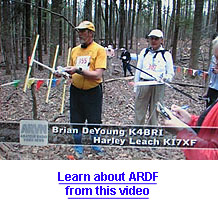
Other articles
- Baldwin, Richard, "Amateur Radio Direction Finding in China," QST Magazine, March 1994, page 22
- Boyd, Jerry and Mileshosky, Brian, "2001 USA Direction Finding Championships," QST Magazine, March 2002
- Holter, Nicolai, "Radio Foxhunting in Europe," QST Magazine, August 1976, page 53 and November 1976, page 43
- Hunt, Dale, "Amateur Radio Direction Finding: The 1998 IARU World Championships," QST Magazine, May 1999, page 28
- Moell, Joe, "World Class Foxhunting Comes to America," CQ VHF Magazine, October 1996, page 16
- Moell, Joe, "The USA Takes on the World Foxhunting Championships," CQ VHF Magazine, March 1999, page 12
- Moell, Joe, "Amateur Radio Direction Finding: USA Holds Its First National Championships," QST Magazine, May 2001, page 57
- Sumner, David, "Direction Finding, European Style," QST Magazine, September 1978, page 38
- Titterington, Bob, "ARDF Finds Its Direction," RadComm (RSGB), April 2005, page 48
- Vigil, Sam, "The US 2004 ARDF Championship: A Beginner's Adventures," CQ Magazine, November 2004, page 44
- Scharlau, Charles, "Radio-Orienteering: Using Sound to Find Your Way," On The Air Magazine, March 2023, page 16
Books
The above references will increase your understanding of international style ARDF and help you plan hunts in your area. For technical and equipment ARDF references, see the Equipment Ideas for Radio-Orienteering page at this site.

What Is The IARU?
 The International Amateur Radio Union (IARU) is a federation of the national Amateur Radio Societies of 146 countries around the world, working together for the international good of Amateur Radio. IARU was formed in Paris, France in 1925 and has become the watchdog and spokesman for the world Amateur Radio community.
The International Amateur Radio Union (IARU) is a federation of the national Amateur Radio Societies of 146 countries around the world, working together for the international good of Amateur Radio. IARU was formed in Paris, France in 1925 and has become the watchdog and spokesman for the world Amateur Radio community.
There are no individual members of IARU, only national Member-Societies such as the American Radio Relay League (USA), Associazione Radioamatori Italiani (Italy), and Federacion Mexicana de Radio Experimentadores (Mexico).
 The IARU Constitution organizes the Union into three Regional Organizations that correspond to the three administrative regions of the International Telecommunication Union (ITU). Each region has a Web page for ARDF activities and an ARDF Coordinator (in parentheses), as follows:
The IARU Constitution organizes the Union into three Regional Organizations that correspond to the three administrative regions of the International Telecommunication Union (ITU). Each region has a Web page for ARDF activities and an ARDF Coordinator (in parentheses), as follows:
ARRL is a member society of IARU Region 2, of course. USA is also a member society of IARU Region 3, by virtue of the US territories, such as Guam, that are located in Region 3. IARU's headquarters (the International Secretariat) is located at the ARRL building in Newington, Connecticut, USA. The current IARU President is Timothy Ellam VE6SH of Canada. The International Secretary is David Sumner K1ZZ of the USA.
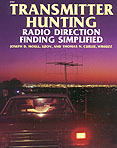 Go to Radio-Orienteering in southern California -- Announcements of upcoming demonstration/practice sessions and results of recent local events
Go to Radio-Orienteering in southern California -- Announcements of upcoming demonstration/practice sessions and results of recent local events
Go to Equipment Ideas for Radio-Orienteering -- Simple and inexpensive receiving and transmitting solutions
Go to Latest Championship Foxhunting News -- Stories of recent multi-nation ARDF events and announcements of upcoming ones
Go to A Video that Explains and Promotes ARDF -- Show it to your local ham radio and orienteering clubs
Go to Electronic Scoring for ARDF -- What it is, how it works, and why it's better than pin punching
Go to Foxhunting for Scouts -- Let's get the kids involved
Go to Try ARDF on 80 Meters -- The "other" foxhunting band
Go to Extenders Aid Handicapped Foxhunters -- A novel way to include persons with disabilities
 Back to the Homing In home page
Back to the Homing In home page
This page updated 4 December 2025
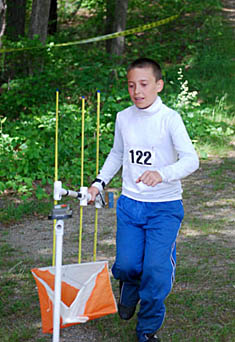 The detailed IARU document "Rules for Championships in Amateur Radio
Direction Finding" is maintained by IARU's ARDF Working Group, comprising delegates from foxhunting countries around the world. (A set of rules specific to the USA has also been created.) Rules for classic competitions call for five low-power (0.25 to 1.5 watt) foxes,
automatically transmitting one after another (never at the same time) on the same frequency for exactly one
minute each. Contestants attempt to locate as many as possible and get to the finish within the
time limit, carrying a card to mark with the unique punches located at
each fox. (A computerized registration/scoring system may also be used.) The start and finish may be at the same place, but usually they are at widely spaced points of the course.
The detailed IARU document "Rules for Championships in Amateur Radio
Direction Finding" is maintained by IARU's ARDF Working Group, comprising delegates from foxhunting countries around the world. (A set of rules specific to the USA has also been created.) Rules for classic competitions call for five low-power (0.25 to 1.5 watt) foxes,
automatically transmitting one after another (never at the same time) on the same frequency for exactly one
minute each. Contestants attempt to locate as many as possible and get to the finish within the
time limit, carrying a card to mark with the unique punches located at
each fox. (A computerized registration/scoring system may also be used.) The start and finish may be at the same place, but usually they are at widely spaced points of the course.
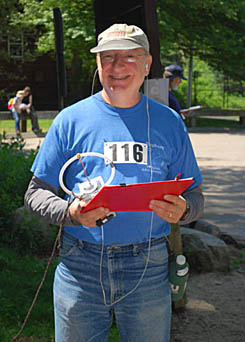 In 1990, Amateur Radio hidden transmitter hunting in the USA was almost exclusively a vehicular activity. A weekend hunt meant hours of driving in a well-equipped vehicle. There might be an on-foot "sniff" at the end to get to a transmitter a few yards off the road, but that was the extent of radio "foxhunting" on foot.
In 1990, Amateur Radio hidden transmitter hunting in the USA was almost exclusively a vehicular activity. A weekend hunt meant hours of driving in a well-equipped vehicle. There might be an on-foot "sniff" at the end to get to a transmitter a few yards off the road, but that was the extent of radio "foxhunting" on foot.
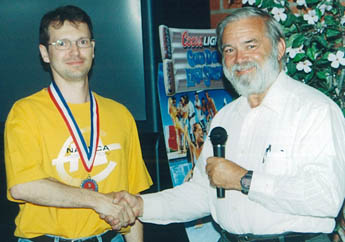 Classic course transmitters must be at least 400 meters apart, with a total optimum-route course distance of
6 to 12 kilometers. Elevation change should not exceed six percent of the course length. The first fox should be at least 750 meters from
the start. A prominent red and white prism (orienteering flag) is located close to each
transmitter for visual identification. This is where the registration device (manual or e-punch) is located. A homing fox at the finish
line transmits continuously on a separate frequency to aid competitors who get
lost. Two meter foxes in European and Asian IARU championships use AM with tone modulation, but FM tones are often used in North America. There is also a separate contest on a different day in all age/gender catetories on
Classic course transmitters must be at least 400 meters apart, with a total optimum-route course distance of
6 to 12 kilometers. Elevation change should not exceed six percent of the course length. The first fox should be at least 750 meters from
the start. A prominent red and white prism (orienteering flag) is located close to each
transmitter for visual identification. This is where the registration device (manual or e-punch) is located. A homing fox at the finish
line transmits continuously on a separate frequency to aid competitors who get
lost. Two meter foxes in European and Asian IARU championships use AM with tone modulation, but FM tones are often used in North America. There is also a separate contest on a different day in all age/gender catetories on
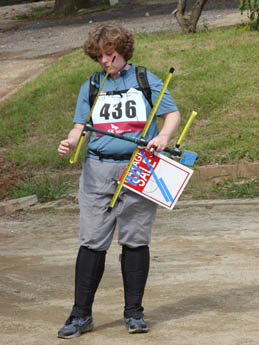
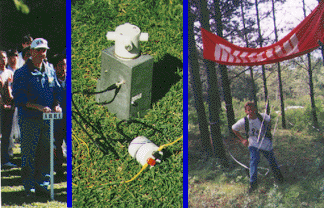 Japan hosted the next Friendship Games in 1997. Because the primary activity of Japan's host club is foxhunting, the foxhunt was the main event. It was fully covered in Homing In for January 1998.
Japan hosted the next Friendship Games in 1997. Because the primary activity of Japan's host club is foxhunting, the foxhunt was the main event. It was fully covered in Homing In for January 1998.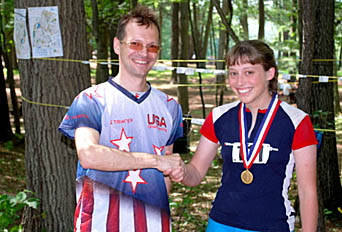 Later that month, the IARU Region 2 Plenary Conference in Venezuela approved a request by FARS to include IARU Region 2 ARDF Championship foxhunts as part of the 1999 Friendship Radiosport Games (FRG-99) in Portland, Oregon, staged during the second week of August 1999. Dale Hunt WB6BYU, Team Leader for the Hungary trip, agreed to be Foxhunt Chair for this event.
Later that month, the IARU Region 2 Plenary Conference in Venezuela approved a request by FARS to include IARU Region 2 ARDF Championship foxhunts as part of the 1999 Friendship Radiosport Games (FRG-99) in Portland, Oregon, staged during the second week of August 1999. Dale Hunt WB6BYU, Team Leader for the Hungary trip, agreed to be Foxhunt Chair for this event.
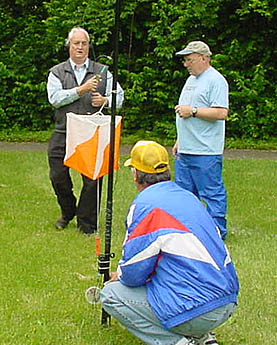 Even more ARDF activity occurred in the USA during 2001, including the
Even more ARDF activity occurred in the USA during 2001, including the 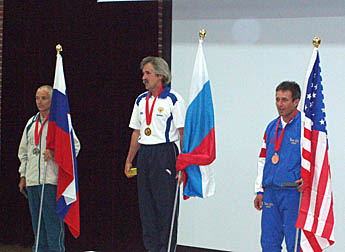 The
The 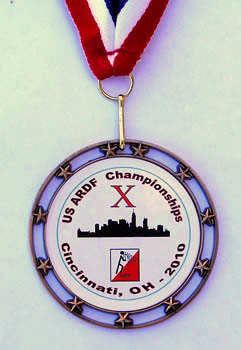 Radio-orienteers returned to the Cincinnati area in 2010 for the
Radio-orienteers returned to the Cincinnati area in 2010 for the 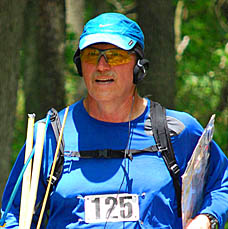
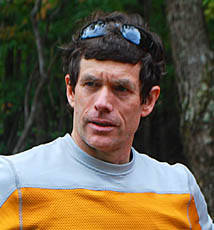 In 2019, I realized that my decreasing available time would be inadequate for all of the growing demands on the position. So I decided it was time to retire. It was important for me to turn my duties over to active and knowledgeable ARDF enthusiasts, so I was pleased when the ARRL President appointed Jerry Boyd WB8WFK of Albuquerque, New Mexico (pictured at left) to succeed me, effective July 1, 2019. Jerry has been involved in ARDF for many years and has been a frequent medal winner at USA's championships. He was a leader of the organizers of the USA and IARU Region 2 ARDF championships in
In 2019, I realized that my decreasing available time would be inadequate for all of the growing demands on the position. So I decided it was time to retire. It was important for me to turn my duties over to active and knowledgeable ARDF enthusiasts, so I was pleased when the ARRL President appointed Jerry Boyd WB8WFK of Albuquerque, New Mexico (pictured at left) to succeed me, effective July 1, 2019. Jerry has been involved in ARDF for many years and has been a frequent medal winner at USA's championships. He was a leader of the organizers of the USA and IARU Region 2 ARDF championships in 
 Not long after I was appointed as USA ARDF Coordinator, I was also asked to serve as ARDF Coordinator for Region 2 of the International Amateur Radio Union (
Not long after I was appointed as USA ARDF Coordinator, I was also asked to serve as ARDF Coordinator for Region 2 of the International Amateur Radio Union (
 The
The 
 The International Amateur Radio Union (IARU) is a federation of the national Amateur Radio Societies of 146 countries around the world, working together for the international good of Amateur Radio. IARU was formed in Paris, France in 1925 and has become the watchdog and spokesman for the world Amateur Radio community.
The International Amateur Radio Union (IARU) is a federation of the national Amateur Radio Societies of 146 countries around the world, working together for the international good of Amateur Radio. IARU was formed in Paris, France in 1925 and has become the watchdog and spokesman for the world Amateur Radio community.
 The IARU Constitution organizes the Union into three Regional Organizations that correspond to the three administrative regions of the International Telecommunication Union (ITU). Each region has a Web page for ARDF activities and an ARDF Coordinator (in parentheses), as follows:
The IARU Constitution organizes the Union into three Regional Organizations that correspond to the three administrative regions of the International Telecommunication Union (ITU). Each region has a Web page for ARDF activities and an ARDF Coordinator (in parentheses), as follows:

